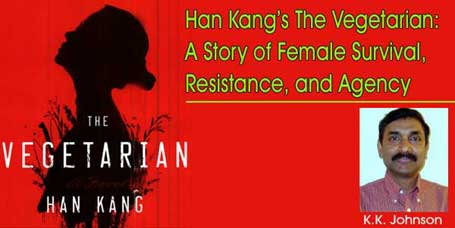
While Korean films and music have gained increasing appeal across multiple countries, cultures, and demographics, it seems that Korean literature has taken a longer time to gain wider recognition and demand – and access may be one of the reasons. In other words, Korean novels and other works of literature do not seem to be translated into other world languages frequently. But this shortage may very well change rapidly, now that Han Kang’s The Vegetarian, has been awarded the 2016, Man BookerInternational Prize. Originally published as three separate novellas and released in South Korea in 2007, the work was translated into English by Deborah Smith, a doctoral student at SOAS, University of London.
An innocuous title like The Vegetarian certainly makes it difficult for readers to gauge what’s beyond the cover of Kang’s work. But as the central character’s(Yeong-hye) story unfolds, we quickly see that her trajectory is one marked with ongoing trauma, escapism,submission to patriarchal domination, active resistance, and reclamation of self.
Following a three-part, episodic structure, Yeong-hye is developed through the narrative threads of her neglectful husband, her obsessed brother in law, and her devoted, successful, but increasingly unhappy older sister. The three parts vividly illustrate Yeong-hye’s fragmentation and perhaps superficial devolution brought on by her decision to stop eating meat and eventually food altogether.Her voice only appearing through dialogue, and expository, cryptic, macabre, and suspense ridden snippets of her dreams that seem to push her deeper and deeper into a consuming physical, emotional, and mental decay.
What this structure seems to accomplish best is the way it illustrates extremely problematic gender norms, the binaries they create, and the violence that women often endure as a result. The most heavily featured male characters, like Mr. Cheong andYeong-hye’s brother in law, seem to embody toxic masculinity: one defined by violence, subjugation of the female body, and an inability to understand women. We see this masculinity played out in brutal scenes where Yeong-hye’s husband forces himself on her, Yeong-hye’s symbolic violationby her father who beats her and tries to force feed her meat when she refuses to break her vegetarianism, and her brother in law’s unrestrained sexual desire and futile attempts at understanding her actions.
But despite the relentless hardship faced by Yeong-hye and even her sister, In-hye, the women in the story are perhaps the most triumphant figures in their ability to defy cultural dictums. Despite the violence enacted against her body, the abandonment she endures, and her gradual physical decay, Yeong-hye remains stalwart in her decision, she chooses her responses and her silences, she aggressively resists attempts to force her into submission. She seems to want only to be like the trees she seeks refuge among in the mountains – both as a child and an adult, “for flowers to bloom from [her] crotch” (154), to exist in silence, to draw her nourishment from the earth, to live outside of humanity’s rules. And while her wishes may seem easy to dismiss as symptomatic of her declining mental state, she holds onto them to the point of self-injury, fighting tooth and nail with an extraordinary, animalistic ferocity and strength.
In-hye’s shrewdness has brought her to a place where she is able to subvert traditional familial roles, becoming the primary bread-winner of her family. The narrator of the third part explains that, “even as a child, In-hye had possessed the innate strength of character necessary to make one’s own way in life” (145).She does, however, perform within Korean gender expectations, as she is a loving mother, and responsible daughter, wife, and sister. Her sense of responsibility toward Yeong-hye never wavers, even when she finds her husband in bed with Yeong-hye. But she has several moments of recognition where she realizes that performing within these roles has prevented her from truly living, and that her proactivity merely masked her “cowardice” (163). Though, it may very well have been how she manages to survive and attain agency.
Yeong-hye and In-hye illustrate two very different means of attaining agency, Yeong-hye through performing within expectations and then aggressively defending herself from impositions on her bodyto8, and In-Hye through understanding early on how to survive despite the inequities she faces in a male dominated society.
The way Kang explores the bleakness of everyday life in the text evokes the surreal and existential in ways reminiscent of Brockden-Brown, Murakami, and even Camus. Her ability to draw out fraught moments throughout the piece in a way that allows the reader to witness and participate in the agony endured by the women is nonpareil. She skillfully paints a crushing reality where the disenfranchised and marginalized are most often the ones forced to wake up from their dreams, but leaves us with enough to feel that it is possible for the outliers to survive.

Comments





